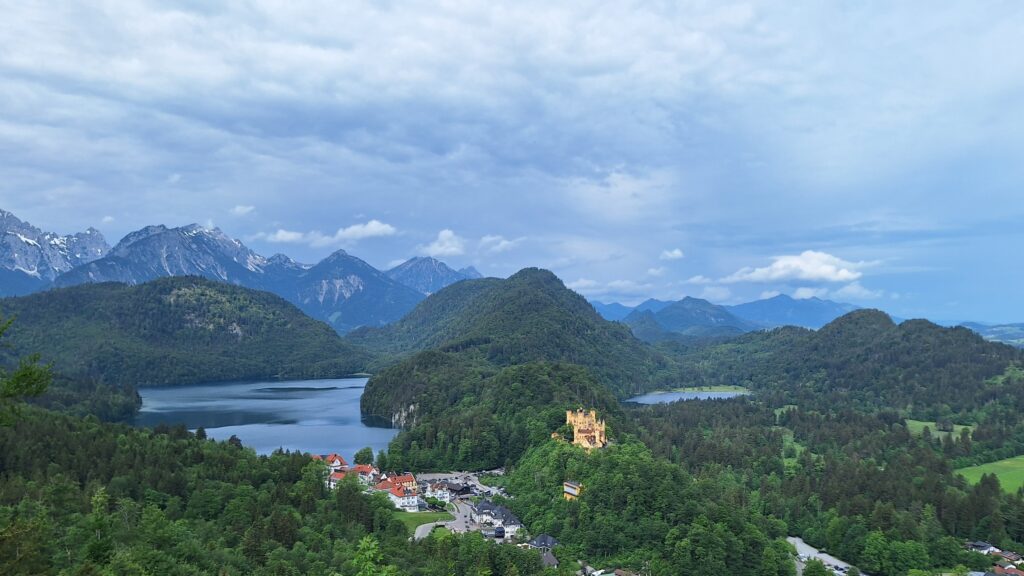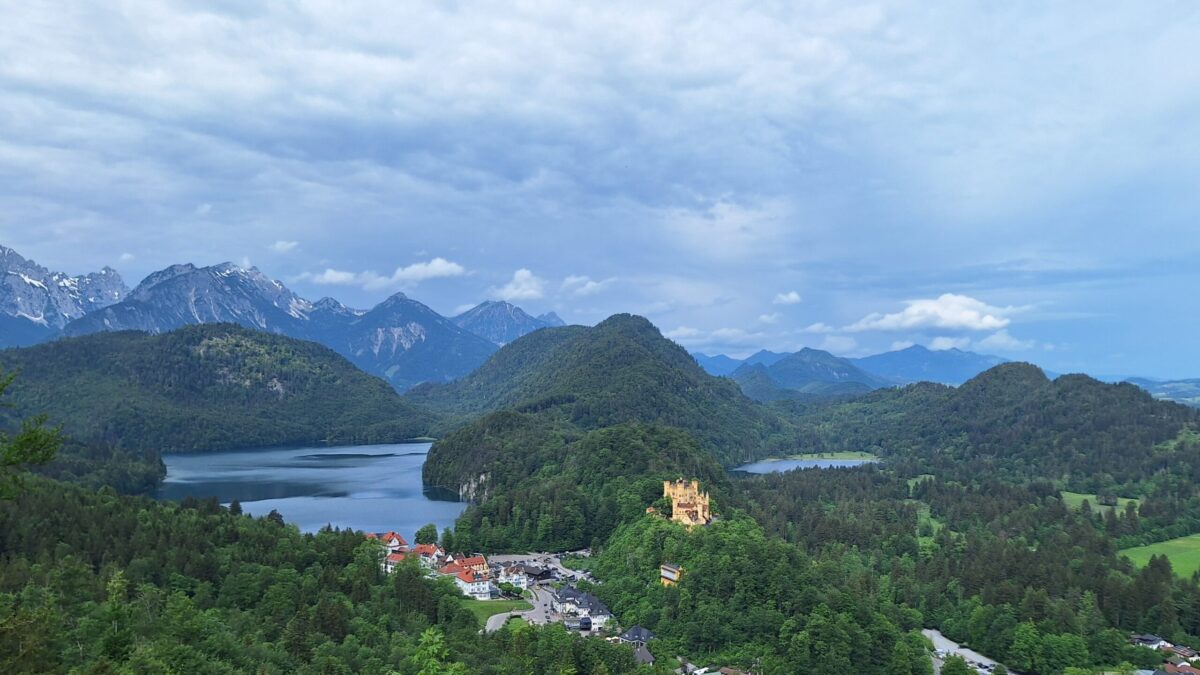Last fall, preparing to lead my own tours to Neuschwanstein, I followed a few tour guides around the castle. The second most spectacular view on the walk to the gate overlooks Hohenschwangau Castle, set on a hill between the lakes Schwansee and Alpsee. All the guides told the gathered group about a dragon that lay in the landscape. They pointed to the castle, saying, “That’s its crown.” They showed the high hill, which is the dragon’s back, and the green hills on either side, its wings. None had a story about the dragon or where it came from or how it got there. I searched online. Nothing.
A dragon, lying right there in plain sight, is intriguing. But, without a story, it’s hardly worth pointing at. I knew I had to make something up. And wouldn’t it be nice if I could relate some real history in the tale’s telling. So I did a little digging in Bavaria’s ancient past. There are lots of good stories back there. The Ostrogoths went through the region before the Franks arrived. Before them, the Romans were there. Before the Romans—and after them too—there were Celts. With Celts come druids… I can work with that.
The following text was previously published on the Peregrine Pages. Adventurers might also find there two other interesting articles: “Neuschwanstein Dungeons” and “3 Possible Ways to Get into the Dungeons of Neuschwanstein.”
And when you are planning an excursion to Bavaria, see “Stephen guides castle tours” and get in touch. I’ll show you around a castle, and we’ll play some D&D!
The Baiuvarii Dragon
After the fall of the Western Roman Empire in the 5th century, Celtic tribes spread out of Bohemia onto the Alpine Foreland and up into the river valleys of the southern mountains. These people became known as the Baiuvarii /by-you-var-ee/, which may have meant “people from Bohemia.” From this word we get Bayern in German and in English Bavaria.
The Baiuvarii were a fierce and independent people. The tribes were led by chieftains. Their spiritual leaders were druids. The druids were wise men and women who served as legal authorities and judges, lore keepers, healers, and advisers to the chieftains.
The druids were also sorcerers. They drew power from nature: from rush of wind, from steady of stone, from fall of water, and from heat of flame.
Then came the Franks from the east. They dominated the Baiuvarii and set up the first dukes to rule over them. The Franks feared the power of the druids and, so, tried to repress them. To defend themselves, the druids called up from the earth a great dragon.
The dragon was big as a mountain. On wide wings, it swooped in the air, its scales were hard as rocks, it moved quick like a river, and it breathed great gouts of fire. The dragon defended the druids against the Franks.
In the 8th century, Charlemagne came. Charlemagne fought the dragon and subdued it. He was then crowned emperor in the year 800. His son Louis the Pious appointed the first king of Bavaria. There followed a series of six Bavarian kings in the 9th century. These kings were fabulously wealthy, the next more wealthy than the previous.
Now the dragon had been subdued but not defeated. And when the last of the six kings died, the dragon collected the treasure of the Bavarian kings and brought it to the Alpsee. It dropped the treasure to the bottom of the lake. The dragon then lay down beside the lake, with the Crown of Bavaria upon its head, and slept.
Do you see the dragon…?

The Crown of Bavaria
The castle is the Crown of Bavaria atop the dragon’s head.
Do you see the dragon?
The dragon’s snout lies in front of the castle. Behind the castle, the hill crest runs up its neck to its back, the tallest hills. Its wings, green hills, spread behind the lakes on either side. The tail stretches into the background, right.
I may have made up parts of this story. Druids are commonly associated with the Celts earlier in history. We don’t hear so much about them later. This is perhaps due to two reasons: one, it was first the Romans, then later Christian conquerors, who repressed the druids for fear of their power, and two, in compliance with their own customs, the druids didn’t write.
I’m sure I’ve exaggerated the Bavarian kings’ wealth, and as far as history is concerned, druids did not call dragons. Some of us know better.

Stephen – we were in your 10am tour today where you told this story of the dragon and I just loved it! I came home to do some research on the history of the region after learning so much from you today. Glad I stumbled upon your page here. Thanks so much for writing this, I was trying to tell my family the story you shared and was missing some details, it’s wonderful that you’ve written it here and I can refer back. Thanks again for today, our visit to Neuschwanstein was so much better because of your knowledge and humor!
Thank you, Kate, for your kind message. I’m happy that you enjoyed the tour. And I love that you’re retelling the dragon story!